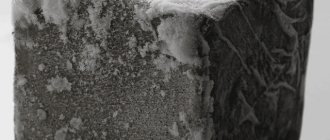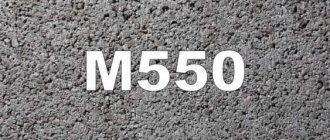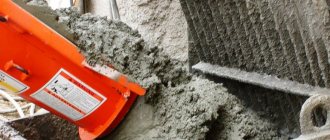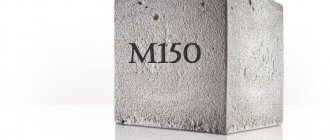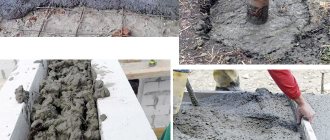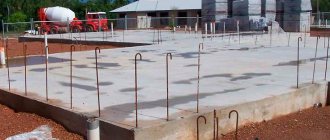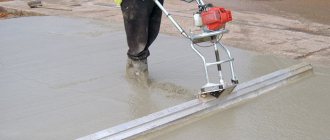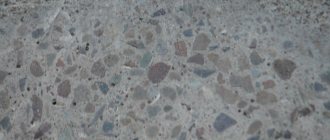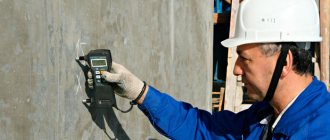BASIC POINTS
1.1. At enterprises in the production of concrete mixtures and the production of prefabricated structures, as well as on construction sites when concreting monolithic structures, statistical control and acceptance of concrete for strength, taking into account homogeneity, must be carried out in accordance with the requirements of this standard.
Acceptance of concrete by comparing its actual strength with the standardized strength without taking into account the characteristics of strength uniformity is not allowed.
1.2. Subject to control:
- tempering strength of concrete - for prefabricated structures without prestressing and prefabricated structures with prestressing, if the tempering strength is higher than the transfer strength;
— transfer strength of concrete — for prestressed structures;
- strength of concrete at the intermediate age established by the design documentation - for monolithic structures (when removing load-bearing formwork, etc.);
— strength of concrete at design age — for prefabricated and monolithic structures.
In cases where the standardized tempering or transfer strength of concrete is 90% or more of that established for a given class (grade), strength control at the design age is not carried out.
1.3. Concrete strength control for each type of standardized strength specified in clause 1.2 is carried out using control data from previous batches in the following order:
— determine the strength of concrete in each of the batches produced during the period established by the standard (analyzed);
— calculate the characteristics of concrete strength uniformity for the analyzed period;
- determine the required concrete strength for the subsequent controlled period based on the characteristics of the uniformity of concrete strength in the analyzed period;
— determine the strength of concrete in a given controlled batch, compare it with the required strength and make a decision on acceptance of this batch.
1.4. The strength of concrete in a batch is determined in accordance with this standard based on the results of testing concrete samples in accordance with GOST 10180 (hereinafter referred to as sample control) or by non-destructive methods in accordance with current state standards for these methods.
When determining the strength of concrete of monolithic structures by non-destructive methods, either the ultrasonic method in accordance with GOST 17624 with through sounding, or the tear-off method with chipping in accordance with GOST 22690 should be used. The use of other non-destructive testing methods is allowed in agreement with the leading research organizations.
The tensile strength of concrete, and at the design age of concrete of prefabricated structures, the compressive strength is determined only from samples.
1.5. As a characteristic of homogeneity used in control to determine the required strength of concrete RT, the average coefficient of variation of strength Vn is calculated for all batches of concrete for the analyzed period.
1.6. Simultaneously with determining the required strength, the average level of concrete strength Ry is calculated for use in selecting the composition of concrete in accordance with GOST 27006 for the upcoming controlled period.
Moreover, if the average level of concrete strength in the upcoming controlled period decreases compared to the previous one (due to the production of concrete with higher homogeneity), then cement consumption should be reduced accordingly.
» Construction Department 47 » +7(8482) 61-61-60
Classes and brands of ready-mixed concrete.
The relationship between the class and grades of concrete in terms of strength.
| Concrete class | Average strength, kgf/sq.cm | Nearest brand of concrete |
| В3.5 В5 В7.5 В10 В12.5 В15 В20 В25 В30 В35 В40 В45 В50 В55 В60 | 46 65 98 131 164 196 262 327 393 458 524 589 655 720 786 | M50 M75 M100 M150 M150 M200 M250 M350 M400 M450 M550 M600 M600 M700 M800 |
The grade of concrete in terms of compressive strength characterizes the resistance to axial compression (kgf/cm2) of the reference cube samples.
The grade of concrete in terms of axial tensile strength characterizes the axial tensile resistance (kgf/cm2) of control samples.
frost resistance grade of concrete is characterized by the number of cycles of alternating freezing and thawing that the samples can withstand under standard test conditions.
waterproof grade of concrete is characterized by one-sided hydrostatic pressure (kgf/cm2), at which concrete samples do not allow water to pass through under standard test conditions.
Uniformity of strength and class of concrete.
Concrete must be homogeneous - this is one of the most important technical requirements. To assess the homogeneity of concrete of a given grade, the results of control tests of concrete samples over a certain period of time are used. The strength of concrete samples will fluctuate, deviating from the average value up and down. Strength is greatly influenced by fluctuations in the quality of cement and aggregates, the accuracy of dosing components, and the thorough preparation of the concrete mixture. To increase the uniformity of concrete, it is necessary to use cement and aggregates of guaranteed quality, and production automation.
To standardize strength, it is necessary to use a standard characteristic that would guarantee the production of concrete of a given strength, taking into account its possible fluctuations. This characteristic is the class of concrete.
The class of concrete is a numerical characteristic of any of its properties, accepted with a guaranteed probability of 0.95. This means that the property set by the class is provided in no less than 95 cases out of 100, and only in 5 cases can it be expected not to be fulfilled.
Concrete is divided into classes : B1; B1.5; AT 2; B2.5; B3.5; AT 5; B7.5; AT 10 O'CLOCK; B12.5; B15; IN 20; B25; B30; B40; B45; B50; B55; B60.
Hardening of concrete.
The strength of concrete increases as a result of physical and chemical processes of interaction between cement and water, which normally occur in warm and humid conditions. The interaction of cement with water stops if the concrete dries out or freezes. Early drying and freezing of concrete irreparably deteriorates its structure and properties.
Concrete needs care to create normal hardening conditions, especially in the initial period after laying (up to 15-28 days). In the warm season, moisture in concrete is retained by watering and covering. Concrete under normal hardening conditions has low initial strength and only after 7-14 days it acquires 60-80% of brand strength
For the grade of concrete for frost resistance
accept the greatest number of cycles of alternating freezing and thawing, which samples of established sizes can withstand during testing without a decrease in compressive strength of more than 5% compared to the strength of samples tested at an equivalent age, and for road concrete, in addition, without a loss of mass of more than 5%. Frost resistance grades have been established: F50, F75, F100, F150, F200, F300, F400, F500.
By water resistance
concrete is divided into grades W2, W4, W6, W8 and W12, with the grade indicating the water pressure (kgf/cm2) at which a 15 cm high cylinder sample does not allow water to pass through under standard test conditions.
The grade of cement is assigned depending on the design grade of concrete in terms of compressive strength:
| Brand concrete | M150 | M200 | M250 | M300 | M350 | M400 | M450 | M500 | M600 higher |
| Brand cement | M300 | M300 M400 | M400 | M400 M500 | M400 M500 | M500 M600 | M550 M600 | M600 | M600 |
Concrete grade M 100 (B 7.5) Ready-mix concrete grade M 100 is used during preparatory work, before pouring monolithic slabs and foundation strips, shallow foundations when groundwater is located below the freezing depth, with additional waterproofing and insulation of the foundation from melt and rainwater around the perimeter buildings (blind areas). In addition, it is used in road construction, as a concrete pad and for installing curb stones.
Concrete grade M 150 (B10) Concrete grade M 150 is used at the stage of preparatory work, namely when pouring the so-called cushion, since it is one of the most inexpensive grades of concrete, pouring floors with low abrasion in heated and unheated rooms (basements, garages) without exposure to aggressive environments. Also, concrete of this grade can be used in the manufacture of screeds, floors, foundations for small structures, concreting paths, etc.
Concrete grade M 200 (B15) Ready-mixed concrete grade M 200 is used mainly in the manufacture of concrete floor screeds, foundations, blind areas, paths, etc. In individual construction, the strength of concrete grade M 200 is quite sufficient to solve most construction problems: strip, slab and pile-grillage foundations; production of concrete stairs, retaining walls, platforms, paths, blind areas, etc. One of the most commonly used grades of concrete.
Concrete grade M 250 (B20) Ready-mixed concrete grade M 250 is used for the construction of monolithic slabs, construction of columns, concrete foundations in wetlands, reinforced concrete structures, foundation slabs, floors, floor slabs, beams, etc., to which high demands are placed. in terms of strength.
Concrete grade M 300 (B22.5) Concrete grade M 300 is used for pouring stairwells, casting paving slabs, building curbs, roads subject to heavy loads, in the production of floor slabs, various wells and pipes, as well as many other critical structures.
Concrete grade M 350 (B25) Ready-mix concrete grade M 350 is used for the manufacture of monolithic foundations, pile-grillage reinforced concrete structures, floor slabs and other critical structures. Concrete grade M 350 is also used for objects that can withstand heavy loads.
| < Previous | Next > |
DETERMINATION OF CONCRETE STRENGTH IN A BATCH
2.1. The batch should include concrete of prefabricated or monolithic structures, molded on one technological complex from a concrete mixture of one nominal composition in accordance with GOST 27006 using one technology for at least one shift and no more than one week.
When testing by samples, a batch of concrete for prefabricated structures may include concrete from one or more batches of structures formed in accordance with current standards or technical specifications for these structures.
When determining the strength of concrete of prefabricated structures using non-destructive methods, concrete from one batch of structures is included in the batch composition.
2.1a. It is allowed to combine concrete of the same strength class (grade) with different nominal compositions into a batch if the following conditions are met:
— the maximum of the average values of the batch coefficient of variation in the strength of concrete for the analyzed period of combined compositions does not exceed 12%;
— the difference between the maximum and minimum values of the batch coefficient of variation in concrete strength for the analyzed period for the combined compositions does not exceed 2%;
— the largest aggregate size and the workability index of the combined compositions differ by no more than two times, and the cement consumption in these compositions differs by no more than 15% from the average value.
The regulated conditions of combination are checked once a year based on the results of determining the statistical characteristics of concrete uniformity in strength separately for each nominal composition for the last two controlled periods.
When combining different compositions into a batch, the value of the coefficient of variation of concrete strength in the first controlled period is determined as the arithmetic mean of the average values of the coefficients of variation for individual nominal compositions.
(Introduced additionally, Amendment No. 1).
2.2. When testing by samples to determine the strength of concrete from randomly selected batches in accordance with GOST 10181.0, at least two samples of the concrete mixture are taken from each batch of concrete (except for cellular concrete) and at least one sample;
- per shift - at an enterprise that manufactures prefabricated structures;
- in 1 day - at the enterprise that produces concrete mixtures for monolithic structures;
- in 1 day - at the construction site for monolithic structures.
By agreement with the design organization carrying out designer's supervision, it is allowed not to take samples of the concrete mixture at the site of laying them in a monolithic structure, but to evaluate the strength of the concrete according to the control data of the enterprise that manufactures the concrete mixture.
2.3. From each concrete mixture sample, one series of concrete samples is made in accordance with GOST 10180 to control: - tempering strength; — transfer strength; — strength of concrete at intermediate ages; — strength of concrete at design age. It is allowed to make a series of control samples to determine the strength of concrete of prefabricated structures at design age, not from each sample, but from at least two samples taken from one batch per week with concrete strength class B30 (grade 400) and below, and four samples selected from two batches per week with concrete strength class B35 (grade 450) and higher.
To control the strength of cellular concrete, at least two series of samples are cut or drilled from finished structures of each batch or from blocks manufactured simultaneously with these structures in accordance with GOST 10180.
2.4. Control samples of concrete of prefabricated structures must harden under the same conditions as the structures before determining the tempering or transfer strength. Subsequent hardening of samples intended to determine the strength of concrete at design age must be carried out under normal conditions at a temperature of (20 ± 2) ° C and a relative air humidity of at least 95%.
Control samples of concrete of monolithic structures at the enterprise that manufactures the concrete mixture must harden under normal conditions, and at the construction site - under conditions identical to the conditions for hardening of structures.
(Changed edition, Amendment No. 1).
2.5. When testing using non-destructive methods to determine the tempering or transfer strength of concrete of prefabricated structures, 10%, but not less than three structures, are selected from the batch.
To determine the strength of concrete of monolithic structures using non-destructive methods at an intermediate age, at least one structure from the volume of concrete laid during each day (or part of the structure in the case when its concreting is carried out for more than 1 day) is controlled.
2.6. For each prefabricated structure selected to determine the strength of concrete using non-destructive methods, at least two, and for a monolithic structure, at least four controlled sections are assigned.
The number and location of controlled sections must be indicated by the design organization in the working drawings of structures depending on the geometric dimensions, purpose and technology of their manufacture and be no less than:
— for linear structures — one section per 4 m length;
- for flat structures, with the exception of monolithic structures of solid walls - one section per 4 m2 of area;
- for monolithic structures of solid walls - one section per 8 m2 of area.
In the absence of instructions in the working drawings, the controlled areas are installed by the manufacturer in agreement with the design or research organization.
The number of measurements performed at each controlled area is taken according to current standards for non-destructive testing methods.
2.7. The strength of concrete in a batch (Rm), MPa, is calculated using the formula
(1)
where Ri is the unit strength of concrete, MPa;
n is the total number of individual concrete strength values in the batch.
The unit value of concrete strength is taken to be:
- when testing by samples - the average strength of concrete in one series of samples, determined according to GOST 10180;
- when testing by non-destructive methods - the average strength of the concrete of the structure or the average strength of the concrete of the controlled section of the structure, determined according to the current state standards for non-destructive testing methods. Instructions for choosing the type of unit strength value when using non-destructive methods are given in Appendix 2.
Class and grade of concrete
The main indicator by which the class and grade of concrete is determined is the compressive strength. Moreover, the guaranteed strength with a permissible error of 13.5% (the so-called coefficient of variation) is reflected by the class of the material; the grade is necessary to indicate the average strength value.
According to SNiP 2.03.01-84, the first indicator is measured in megapascals (MPa) and is designated by the letter “B” of the Latin alphabet. For example, the designation “B25” says that the material can withstand pressure of 25 MPa in 95% of cases. The full range of B is from 3.5 to 80, with the main range including B values of 7.5-B40. The strength of concrete is specified by the “M” grade and numbers ranging from 50-1000, reflecting the average compressive strength (measured in kgf/cm²). The main range includes compositions M100-M500.
What does the class of concrete depend on?
- cement content. The higher the cement content in the mixture, the higher the strength of the final product;
- cement activity. Higher strength cements produce more reliable structures.
- water cement ratio. As the W/C ratio decreases, strength increases. This is explained by the structure of the composition: excess water contributes to the formation of excess pores in concrete, which worsen its technical characteristics.
- quality of aggregates. The use of fine-grained fillers, fine dust fractions, clay, and organic impurities contributes to a decrease in the strength of the composition.
- the degree of compaction of the concrete mass and the quality of its mixing. The performance characteristics of the composition can be increased using turbo and vibration mixing and compaction of the mixture.
Table of the ratio of classes and grades of concrete
As the compressive strength grade of concrete increases, the tensile strength increases, but the increase in tensile strength becomes less significant in the area of high-strength types. The tensile strength of the material is 1:10 - 1:17 to the ultimate compressive strength, while the flexural strength is 1:6 - 1:10.
The maximum permissible strength threshold of the composition is individual for each brand.
Compositions with higher M values have the lowest critical strength. Critical indicators are reached on the first day after pouring the mixture.
Control samples
Compressive strength is tested in laboratories using manufactured samples in accordance with GOST requirements. However, you can check the brand compliance yourself at the construction site.
To do this you need:
- prepare wooden molds with internal edge dimensions of 100x100x100 mm;
- take a sample of the concrete mixture from the mixer tray and pour several cubes into pre-prepared molds;
- compact the composition by pinching it in several places or by hitting the shape with a hammer. This measure allows you to eliminate air bubbles formed in the mixture;
- keep the resulting cubes at a humidity of 90% and a temperature of +20°C, excluding direct exposure to the sun’s rays;
- after 28 days, transfer concrete samples to the laboratory for examination. It is possible to submit some samples at intermediate stages of solidification (on the 3rd, 7th and 14th days) for preliminary examination.
Carrying out these activities will allow you to determine whether the brand and class of concrete that was brought to the construction site corresponds to what you ordered.
aquagroup.ru
DETERMINATION OF CONCRETE HOMOGENEOUSITY CHARACTERISTICS BY STRENGTH
3.1. The duration of the analyzed period to determine the characteristics of concrete homogeneity is set from one week to 2 months. The number of individual concrete strength values during this period should be at least 30.
3.2. During the analyzed period, the standard deviation Sm and the coefficient of variation Vm of strength are calculated for each batch of concrete. The specified characteristics are calculated for all types of standardized strength according to clause 1.2. In this case, it is allowed not to calculate the coefficient of variation in the strength of concrete at the design age for prefabricated structures, but to take it equal to 85% of the coefficient of variation of the tempering strength.
3.3. When testing by samples, the standard deviation of the strength of concrete in a batch (Sm), MPa, with the number of single values of concrete strength in a batch n greater than six, is calculated using the formula
, (2)
If the number of individual concrete strength values in a batch is from two to six, the value of Sm is calculated using the formula
(3)
where Wm is the range of unit strength values of concrete in the controlled batch, defined as the difference between the maximum and minimum unit strength values, MPa;
a is a coefficient that depends on the number of unit values (n) and is taken according to the table. 1.
Table 1
| Number of single values | P | 2 | 3 | 4 | 5 | 6 |
| Coefficient value | a | 1,13 | 1,69 | 2,06 | 2,33 | 2,5 |
When testing using non-destructive methods, in the case where the average strength of the concrete structure is taken as a single value, the value of St, MPa, is calculated taking into account deviations of the calibration dependence according to the formula
, (4)
where ST is the standard deviation of the calibration dependence, determined according to the current state standards for non-destructive methods, MPa;
n is the number of single values (controlled structures) in the batch;
p is the number of controlled areas in the structure. In the case when the strength of concrete in the controlled area is taken as a single value, the value of Sm, MPa, is calculated using the formula
, (5)
where Kn is the correction factor determined according to Appendix 2;
n is the number of individual concrete strength values (controlled areas) in the batch.
3.4. The coefficient of variation in the strength of concrete in a batch (partition coefficient) (Vm) in percent is calculated using the formula
(6)
3.5. The average value of the batch coefficient of variation in concrete strength for the analyzed period (n) in percent is calculated using the formula
, (7)
where Vm, i are the coefficients of variation of concrete strength in each i-th of n batches of concrete monitored during the analyzed period, calculated by formula (6);
ni is the number of single values of concrete strength in each i-th of n batches of concrete monitored during the analyzed period;
- the total number of individual values of concrete strength for the analyzed period (at least 30).
3.6. When monitoring the strength of concrete at a construction site, the coefficient of variation of concrete strength is taken according to the document on the quality of the concrete mixture of the manufacturer.
3.7. When monitoring irregularly produced prefabricated structures and concrete mixtures, it is allowed to take the coefficient of variation equal to the coefficient of variation of concrete of a different composition, provided it is manufactured using the same technology and the same materials and differs in strength by no more than two classes (grades).
DETERMINING THE REQUIRED STRENGTH OF CONCRETE
4.1. The required strength of concrete (tempering, transfer, at intermediate or design ages) when normalizing strength by class (Pt), MPa, is calculated using the formula
RT = KT Bnorm, (8)
where Bnorm is the standardized value of concrete strength (tempering, transfer, at intermediate or design age) for concrete of a given class in terms of compressive strength, axial tension or bending tension, MPa;
KT is the coefficient of required strength for all types of concrete, adopted in accordance with table. 2 depending on the average coefficient of variation of concrete strength Vn for all batches for the analyzed period, calculated using formula (7).
When using non-destructive methods for monitoring the strength of concrete in cases where the concrete strength of the controlled section of the structure is taken as a single value, the right side of formula (8) should be multiplied by a coefficient equal to 0.95.
4.2. The required strength of concrete when normalizing strength by grade is determined in accordance with Appendix 3.
table 2
| KT | ||||
| Vn% | for all types of concrete (except dense silicate, cellular) and structures, except massive hydraulic structures | for dense silicate concrete | for autoclaved cellular concrete | for massive hydraulic structures |
| 6 or less | 1,07 | 1,06 | 1,08 | 1,09 |
| 7 | 1,08 | 1,07 | 1,09 | 1,10 |
| 8 | 1,09 | 1,08 | 1,10 | 1,11 |
| 9 | 1,11 | 1,09 | 1,12 | 1,13 |
| 10 | 1,14 | 1,12 | 1,13 | 1,14 |
| 11 | 1,18 | 1,14 | 1,14 | 1,16 |
| 12 | 1,23 | 1,18 | 1,17 | 1,18 |
| 13 | 1,28 | 1,22 | 1,22 | 1,20 |
| 14 | 1,33 | 1,27 | 1,26 | 1,22 |
| 15 | 1,38 | 1,33 | 1,32 | 1,23 |
| 16 | 1,43 | 1,39 | 1,37 | 1,25 |
| 17 | 1,46 | 1,43 | 1,28 | |
| 18 | 1,50 | 1,32 | ||
| 19 | Invalid area | 1,57 | 1,36 | |
| 20 | values | 1,39 | ||
| 21 or more | ||||
4.3. If necessary, control the strength of individual concrete. batches, the coefficient of required strength can be taken from the table. 2 or Appendix Table 3, depending on the coefficient of variation in the strength of concrete in a given batch, calculated using formula (6). In this case, the number of individual concrete strength values in this batch must be at least 30.
4.4. In the initial period, before the accumulation of the number of test results necessary for statistical control, the required concrete strength (RT) is determined by the formula
RT = (10)
where Kb is the coefficient adopted according to the table. 3 depending on the type of concrete.
Table 3
| Type of concrete | KB |
| 1. For all concretes (except cellular and dense silicate) | 0,78 |
| 2. Cellular | 0,70 |
| 3. Dense silicate | 0,75 |
4.5. The duration of the controlled period during which the established value of the required strength can be used should be taken from one week to 1 month.
Class of concrete for tensile bending
Concrete is a universal material. It is used not only to create structures with straight shapes, but also to produce concrete products with curved shapes. An important characteristic of mixtures of this type is their tensile bending class. This parameter is also important for road concrete. It is indicated in the labeling by a numerical indicator after the abbreviation “Btb” and is calculated in MPa. According to this criterion, classes Btb0.4 – Btb8.0
in increments of 0.4 MPa. The flexural tensile strength of concrete is always lower than the load capacity of this mixture. This parameter of the concrete solution is taken into account at the design stage of a building or concrete structure. The higher the class of concrete for this parameter, the greater the bending load the mixture can withstand without losing its shape and solidity.
ACCEPTANCE OF CONCRETE BY STRENGTH
5.1. Concrete batches for prefabricated structures are accepted according to their tempering and transfer strength, and for monolithic structures - according to the strength of concrete at the design age.
5.2. A batch of concrete is subject to acceptance if the actual strength of concrete in the batch (Rm) is not lower than the required strength (R?), i.e.
Rm? R? (eleven)
5.3. Monitoring the strength of concrete of prefabricated structures at design age is carried out periodically within the time limits established in clause 2.3, by comparing the required strength at design age with the average strength of concrete at this age of all batches inspected during the week.
The strength of concrete of prefabricated structures at design age is recognized as meeting the requirements of this standard if the condition of formula (11) is met. In this case, the test results apply to all batches of concrete produced during the week.
If this condition is violated, the manufacturer is obliged to notify the consumer about this within three days after completion of all tests.
5.4. The possibility of using batches of structures whose concrete strength does not meet the requirements of paragraphs. 5.2 and 5.3 must be agreed with the design organization.
The same approval is necessary for the further manufacture and use of structures if the average batch coefficient of variation for the subsequent controlled period falls into the area of unacceptable values.
5.3, 5.4. (Changed edition, Amendment No. 1).
5.5. The values of the actual and required strength of concrete must be indicated in the document on the quality of a batch of prefabricated structures in accordance with GOST 13015.3 or concrete mixture in accordance with GOST 7473 and in the concrete work log for monolithic structures.
DETERMINATION OF THE AVERAGE STRENGTH LEVEL OF CONCRETE
6.1. The average level of tempering strength for the controlled period, transfer strength for prefabricated structures, at intermediate and at design age for monolithic structures) of concrete (R?), MPa, is determined by the formula
Rу = R? Km.p, (12)
where Km.p is the coefficient adopted according to the table. 4 depending on the average coefficient of variation Vn for the analyzed period.
Table4
| Vn, % | 6 or less | From 6 to 7 | From 7 to 8 | From 8 to 10 | From 10 to 12 | From 12 to 14 | 14 or more |
| Km.p | 1,03 | 1,04 | 1,05 | 1,07 | 1,09 | 1,12 | 1,15 |
In this case, the value of Km.p should be taken for heavy and light concrete no more than 1.10, and for dense silicate concrete - no more than 1.13.
6.2. It is allowed that the actual average strength of concrete of prefabricated structures at the design age () exceeds the required one (), which is characterized by a coefficient (Kv) calculated by the formula
(13)
The Kv values calculated using formula (13) are compared with the values given in the table in Appendix 4.
(Changed edition, Amendment No. 1).
6.3. In cases where concrete, selected by the laboratory of the manufacturer from the conditions of ensuring the design grade for water resistance, frost resistance or other requirements, must have an average strength higher than the average strength level at the design age, calculated using formula (12), then as an average level take the strength determined when selecting the composition.
6.4. The upper warning limit of the average strength of concrete in the controlled batch (), MPa, the excess of which indicates an overestimation of the actual strength, is calculated using the formula
, (14)
where Vm.p is the coefficient of inter-batch variation of strength, taken equal to 0.5 Vn.
6.5. If the strength of concrete in three batches in a row is higher or the actual average strength level for the controlled period exceeds the average strength level calculated by formula (12), or the value of the Kv coefficient determined by formula (13) is higher than the values given in Appendix 4, then measures should be taken to reduce the strength of concrete and reduce cement consumption.
ANNEX 1
Information
BASIC TERMS, EXPLANATIONS AND CONVENTIONS
| Term | Symbol | Explanation |
| 1.Normed strength of concrete | The strength value specified in the normative-technical or design documentation (at design and intermediate ages, release, transfer) | |
| 2. Required concrete strength | RT | The minimum acceptable value of the actual strength of concrete in a batch, established by laboratories of enterprises and construction sites in accordance with its achieved homogeneity |
| 3. Actual strength of concrete in the batch | Rm | The average strength of concrete in a batch, determined from the results of testing control samples or using non-destructive methods directly in the structure |
| 4. Average level of concrete strength | Ry | The average value of concrete strength, established by laboratories of enterprises and construction sites for a certain controlled period in accordance with the achieved homogeneity of concrete in strength, for which its composition is selected and which is maintained in production |
| 5. Design age of concrete | The concrete hardening time established in the normative-technical or design documentation, during which the strength corresponding to its class or grade must be achieved | |
| 6. Sample | According to GOST 10180 and GOST 10181.0 | |
| 7. Sample series | According to GOST 10180 | |
| 8. Controlled area | The section of the structure where measurements are taken to control the strength of concrete using non-destructive methods | |
| 9. Analyzed period | The period of time over which the batch average strength variation coefficient is calculated to assign the required strength during the subsequent controlled period | |
| 10. Controlled period | The period of time during which the required strength is assumed to be constant in accordance with the coefficient of variation for the previous analyzed period | |
| 11. Technological complex | One of several technological lines of the plant, for which the strength of concrete of the same nominal composition, prepared using the same technology and hardened under the same conditions, is monitored using one batch variation coefficient Vn, calculated for the analyzed period |
Compliance issue
It would seem that there is a correspondence between brands and classes of concrete, because kg/cm² is easy to convert to MPa. In fact, everything is somewhat different.
Table values and GOST
There are more standardized classes of concrete than there are grades. The brand step is very small - this is a more accurate indicator. Here is a table of correspondence between the brand and class of concrete:
| Class | brand | average strength, kgf/cm² | Deviation of brand from class, % |
| 3,5 | 50 | 45,8 | +9,2 |
| 5 | 75 | 65,5 | +14,5 |
| 7,5 | 100 | 98,2 | +1,8 |
| 10 | 150 | 131,0 | +14,5 |
| 12,5 | 150 | 163,7 | -8,4 |
| 15 | 200 | 196,5 | +1,8 |
| 20 | 250 | 261,9 | -4,5 |
| 22,5 | 300 | 294,7 | +1,8 |
| 25 | 350 | 327,4 | +6,9 |
| 27,5 | 350 | 360,2 | -2,8 |
| 30 | 400 | 392,9 | +1,8 |
| 35 | 450 | 458,4 | -1,8 |
| 40 | 500 | 523,9 | +5 |
| 45 | 600 | 589,4 | +1,8 |
| 50 | 700 | 654,8 | +6,9 |
| 55 | 700 | 720,3 | -2,8 |
| 60 | 800 | 785,8 | +1,8 |
| 65 | 900 | 851,3 | +5,7 |
| 70 | 900 | 916,8 | -1,8 |
| 75 | 1000 | 982,3 | +1,8 |
| 80 | 1000 | 1047,7 | -4,6 |
The concrete classes in the table are taken from GOST 26633–91, which regulates the technical conditions for heavy and fine-grained concrete. Calculated data on average strength are used in design, and a certain margin is added to the required indicator.
Legality of terminological replacement
In 2020, the table was removed from GOST - it misleads people. The fact is that class is an actual characteristic , and applying this concept to a concrete mixture is simply inappropriate. When they talk about class, we are talking about guaranteed strength. If a buyer in a store bought a jumper, installed it in the opening, loaded it in accordance with the declared class, and it cracked, the seller and the manufacturer will be held responsible, since they sold a low-quality product.
From this we can conclude: the term “class” can only be used in relation to ready-made concrete, and tested one at that. The sale of ready-mixed concrete can be carried out indicating its brand, but not its class. The actual strength of such concrete will be known no earlier than after 28 days, and it depends not only on the proportions of the mixture components, but also on compliance with the technology of its laying.
The non-compliance of ready-mixed concrete with the declared brand can also be proven and the seller can be held accountable. But in this case, the spread of the permissible strength value will be greater, and the seller may have well-founded doubts about the quality of the installation.
APPENDIX 2
Mandatory
ADDITIONAL REQUIREMENTS FOR CONTROL OF CONCRETE STRENGTH BY NON-DESTRUCTIVE METHODS
1. For non-destructive testing, the following is taken as a single value:
- when monitoring structures of flat and hollow-core floor slabs and coverings, road slabs, panels of internal load-bearing walls, wall blocks, as well as pressure and free-flow pipes - the average strength of the concrete of the structure, calculated as the arithmetic average of the strength of the concrete of the controlled sections of the structure;
- in all other cases, including monolithic and prefabricated-monolithic structures, - the average strength of concrete of the controlled section of the structure (or part of a monolithic, prefabricated-monolithic structure).
2. Control of concrete strength by non-destructive methods (ultrasonic pulse or mechanical) in the case where the average strength of concrete in a structure is taken as a single value is carried out using a calibration relationship previously established in accordance with the requirements of current state standards for these methods.
3. Monitoring the strength of concrete by non-destructive methods in the case when the average strength of concrete in the controlled area is taken as a single value is carried out using the correction factor Kp in formula (5) of section. 3, which is determined before starting the transition to these methods with each change in the nominal composition of concrete, the manufacturing technology of the structure, the type of materials used, with each new establishment of a calibration dependence, but at least once a year.
The Kp coefficient is calculated using the formula
Kp = ,
where Vn.m is the coefficient of variation in the strength of concrete of all series of samples tested by non-destructive method to establish the calibration dependence;
Vo is the coefficient of variation in the strength of concrete of the same series of samples. tested by loading to establish the calibration dependence.
To establish the calibration dependence, the value of the coefficients of variation Vo and Vn.m is determined using a formula similar to formula (7) of section. 3.
APPENDIX 3
Mandatory
DETERMINATION OF THE REQUIRED STRENGTH OF CONCRETE WHEN STANDARDIZING IT BY GRADE
1. The required strength of concrete (tempering, transfer, at intermediate or design age) when normalizing strength by grade (RT), MPa, is calculated using the formula
RT = Rnorm, (1)
where Rnorm is the standardized value of concrete strength (tempering, transfer, intermediate or design age) for concrete of a given grade in terms of compressive strength, axial tension or bending tension, MPa;
К?Т - coefficient of required strength in percentage for all types of concrete, taken in accordance with the table of this appendix depending on the average batch coefficient of variation of concrete strength Vn for the analyzed period, calculated according to formula (7) section. 3.
| K?T % | ||||
| Vn% | for all types of concrete (except dense silicate cellular) and structures, except massive hydraulic structures | for dense silicate concrete | for autoclaved cellular concrete | for massive hydraulic structures |
| 6 or less | 83 | 83 | 75 | 85 |
| 7 | 84 | 83 | 76 | 86 |
| 8 | 85 | 84 | 77 | 87 |
| 9 | S7 | 85 | 78 | 88 |
| 10 | 89 | 87 | 79 | 89 |
| 11 | 92. | 89 | 80 | 91 |
| 12 | 96 | 92 | 82 | 92 |
| 13 | 100 | 96 | 85 | 94 |
| 14 | 104 | 100 | 88 | 95 |
| 15 | 1108 | 105 | 92 | 96 |
| 16 | 112 | 110 | 96 | 98 |
| 17 | 115 | 100 | 100 | |
| 18 | 105 | 103 | ||
| 19 | Invalid area | 110 | 106 | |
| 20 | values | 109 | ||
| 21 or more | ||||
When using non-destructive methods for monitoring the strength of concrete, in cases where the concrete strength of the controlled section of the structure is taken as a single value, the right side of formula (1) should be multiplied. by a coefficient equal to 0.95.
2. In the initial period, before the accumulation of the number of test results required for statistical control, t is determined by the formula
Rt = 1.1? Rnorm. (2)
3. The duration of the controlled period is taken in accordance with clause 4.5 of this standard.
Brand and class - what's the difference?
The class of reinforced concrete is the main numerical indicator that guarantees characterization of its properties (strength). This means that the property set by the class is almost always achieved.
The standard establishes the following:
- the compressive strength of the material is determined by classes B3.5 - B15, with numerical increments of 1.5 units; and B20 – B80, in increments of 5 units. Modern mixtures may belong to intermediate classes;
- axial tensile strength Reinforced concrete performs worse in tension, which can be seen from the tensile strength parameters. Steel reinforcement is used specifically to increase the load-bearing capacity in tension or bending;
- bending strength Btb 40 – 8.00, in increments of 0.4 units.
Based on the indicated parameters, one can, for example, understand that class B20 concrete, with a security of 0.95, is characterized by a compressive strength of at least 20 MPa (200 kg/cm²). The numerical value indicates the tensile strength in MPa
Concrete grade is a numerical characteristic of properties, which is calculated as the average value of sample test results . The indicator does not cover the change in strength in the full volume of the structure. For designation, it is customary to use the index M and a numerical value (from 50 to 1000). For example, the M500 brand says that the compressive strength of the material is at least 500 kgf/cm².
